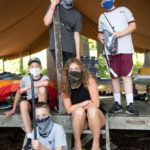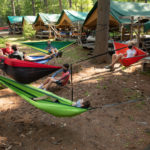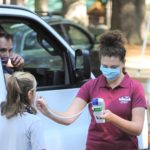Camp and Good Health The 2020 Season
Last spring, with the 2020 camp season approaching and COVID-19’s unpredictable impact, camp owners and directors across Maine may have been certain of only one thing: uncertainty.
Camp professionals faced the challenges of assessing CDC and state COVID-19 guidelines, the daunting task of evaluating their programmatic and physical capacities considering the virus, and the difficult reality of financial ramifications posed by the pandemic. Uncertainty may be an understatement.
Only around 20 of the state’s more than 200 youth camps opened their doors for the 2020 season, but their strategies to best ensure healthy campers and staff worked. Camp 2020 certainly included program modifications and strict adherence to safety protocols, but camp directors say the efforts reaped huge rewards. Kids had time outdoors, away from screens, and among friends. Staff were able to perform their essential roles and benefit from close in-person relationships after being sheltered at home themselves. And while directors wore more hats than ever, they once again saw their magical missions at work.

As for every industry, camps were upended by spread of COVID-19 beginning last March. Maine camp directors began to assess how their own operations would – or could – respond. Heading into May, camps still did not have definitive answers as to what public health measures they would need to follow – if indeed federal and state decision-makers would permit opening at all. Most camps began to make the wrenching decision to suspend their seasons. But as State of Maine and CDC guidelines emerged, camps that chose to open had taken stock. Program modifications, crystal clear safety protocols, staff availability, and parent buy-in provided key ingredients to green-lighting the season. And in August, the camp communities celebrated not only good health, but also the satisfaction of providing that timeless joy of camp just when kids may have needed it most.
Making Changes to Make It Work
In Raymond, girls’ Camp Wawenock’s program looked vastly different. Instead of their traditional single, seven-week session, owners/directors Andy Sangster and Catriona Logan Sangster offered two, 17-day sessions. Younger girls attended the first session and older campers the second; all told, Camp Wawenock hosted less than half of their typical enrollment of 100-plus campers. Campers and staff alike undertook 14-day quarantines prior to arrival, and when staff arrived for preseason training, they began weeks in the camp “bubble” that lasted until the close of camp. Except for running on the quiet rural road leading into camp, staff members stayed put.
Procedures to best ensure health and safety led the Sangsters to cohort campers into “households” of between two and four cabins; in those communities, masks could come off. Dining hall arrangements were changed. And, of course, handwashing, frequent cleaning, and distancing outside households, were the norm.
“We changed how Wawenock does things,” said Logan Sangster, “but we still did everything we [typically] do.”
The season now over, she acknowledged “it is hard to distill it down. Everyone felt very empowered by what we had done. Kids and staff alike.”
“It felt like we sort of defeated the odds, by doing something that was groundbreaking,” she said.
This was new terrain, and Logan Sangster said the entire camp community needed to fully “buy-in” to every modification, every health and safety protocol. From parents to staff to children, an essential ingredient to success was embracing that layered system of safety protocols to best ensure a healthy summer, she said.

Significantly, Camp Wawenock did not undertake any onsite COVID testing. Logan Sangster pointed to expenses and other logistical concerns and said their confidence in a multi-faceted plan for addressing virus risk contributed to the choice to forego tests. Their season was not only COVID-free, but also healthier than typical summers, she said.
Good health abounded at camps that opened, an outcome stemming from unwavering commitment to health and safety protocols. And while camps’ specific approaches varied, they all focused on mutual trust and respect, strict adherence to protocols, and a spirit of flexibility.
At other camps throughout the state, varied but similar approaches had equally good results; one director described it as an “extraordinary” summer.
The Vital Role of Systems
Andy Lilienthal, owner and director of Fayette boys’ Camp Winnebago, said their healthy season, start to finish, worked thanks to well-planned systems “that followed guidelines based on science.” Unlike Camp Wawenock, Winnebago conducted staff-wide testing upon arrival (which followed their at-home quarantine). After small-group training for more than a week, repeat staff testing again produced 100 percent negative results. Staff then enjoyed looser restrictions. Camp owner Andy Lilienthal described it as the “carrot,” a taste of “what the community could be like if we held strictly to protocols.”
Winnebago campers, following at-home quarantine and pre-camp testing, were also grouped in cohorts. Five days after camper arrival, on-site testing produced across-the-board negative results. And after a couple of weeks, Lilienthal said, restrictions relaxed, including outdoor masking requirements. But the camp never gathered in large groups indoors, and adherence to public health protocols continued in full force, including daily symptom and temperature checks.
Laura Blaisdell, Lilienthal’s wife and Winnebago’s medical director is both a physician and public health expert. She was instrumental in developing the camp’s systems and shared her expertise throughout the camping community. At summer’s end, Lilienthal says, Blaisdell was “pleased and relieved.”
“We understand with systems and process and adherence to guidelines and science, we can do this,” he says.
At Camp Wigwam, a boys’ camp in Waterford, owner/director Bob Strauss also relied on a thorough and layered approach, reported a healthy, happy outcome. Staff quarantined during training, were tested, and “knew there was light at the end of the tunnel” if they followed protocols, he said. The 145 campers initially cohorted, and the entire camp community – “Wigwam nation,” – was tested for COVID-19. “It was a very emotional day when we got that [negative] test,” he said.
The camp made program changes that provided helpful planning for future summers, Strauss said. For example, the “International Wigwam Athletic League,” played in-camp competitions rather than customary inter-camp games. “So much of our programming will remain for future seasons,” he said. “There was much more focus on ‘in-camp’ activities as opposed to trips and events outside of the camp environment.”
Other Approaches to A Successful Season
In Belgrade, girls’ Camp Runoia created an entirely new program, a three-week session they called “Harmonyville,” said director Alex Jackson. “The mindset was a big piece of it, not expecting it to be the same.”
Staff members were re-interviewed, for example. And just like other camps, Runoia required its staff to stay on-site for the duration of training and camp. Campers moved in cohort groups for the first two weeks and did activities in cabin groups. “Neighborhoods,” similar to Camp Wawenock’s “households,” enabled interaction in larger groups. In addition, Runoia conducted COVID testing camp-wide about five days in, in addition to requiring campers to have a negative test result pre-camp. Like other camps, the camp community was healthier than ever, Jackson said.

Handwashing and sanitizing – dozens of times a day – had benefits beyond fighting the pandemic. Indeed, the Association of Camp Nurses has quipped that the pandemic alone has accomplished the same task as a century of camp nurses’ efforts to promote handwashing.
The Vital Element of Connection
In Stoneham, Camp Susan Curtis modified its traditional four 12-day sessions to three 10-day sessions. Like Camp Wawenock, Camp Susan Curtis conducted no COVID-19 testing of staff or campers, in large part due to its expense and as well as the position of camp families. The tuition-free camp, which serves economically disadvantaged Maine children referred by school personnel, welcomed 92 campers on-site, as opposed to the several hundred campers it typically hosts. The camp also modified its program by hosting only campers in grades eight through 12.
That choice was partly motivated by the hope of “keeping [that age group] on track” for joining the staff in the future, said Director Terri Mulks. In addition, “we knew there were so many rules and regulations we had to be sure we had kids who could comprehend and follow through.”
Decisions around if and how to open camp were entirely mission driven, Mulks emphasized. “We decided we wouldn’t open if we had to mask,” she says. “Our campers wouldn’t be able to do that.” In addition, each session included only about 30 youngsters, enabling the full camp to operate as a single cohort. The typically “touchy feely” camp had to adjust to air hugs and air high-fives, she said, but campers shared their tremendous care and appreciation for one another nonetheless.
Mulks said that because campers experienced a “hugely vulnerable time” this spring it was a top priority to bring these youngsters to be together. Watching campers interact was evidence of how important that connection was, she said. “All the kids ended up where they could stand around and talk. That’s what they wanted to do.” At the waterfront, staff saw them simply “standing in the shallow section.”
“It was hilarious,” she said. “We were saying ‘why is no one doing anything?’”
“They were just feeling good. They really bonded with one another,” she said. “They’re always making strong connections, but this was so visible.”

Just like other camps that opened, Camp Susan Curtis’s on-site protocols started with drop-offs at which only campers left vehicles. A three-step check-in including screening questions and temperature-taking, waiver signatures, and unloading luggage.
Once sessions were underway staff conducted modified screenings daily, including temperature recording, and “scrub in, scrub out” – using hand sanitizer upon every entrance and every exit. “Every decision was based on what’s best for kids,” Mulks said. That focus and direction did not waver. From campers relaxing and chatting on floats in the lake to dancing on the beach, “it was such a wonderful time,” she said.
“It was all just kind of like ‘this is the very reason why we are here.’ These kids need respite. We can provide that. Honestly, they do not have anyplace else.”
That acute awareness of children’s needs was also the impetus for Camp Susan Curtis’s summer outreach effort – the creation and distribution of hundreds of “activity kits” at summer food service programs. Five staff members worked on the project. “The assembly was hard, but they loved traveling.”
A team of three made those road trips, including camping for a week while providing outreach to the Presque Isle and Calais region. That team also rode food delivery busses to food service sites to hand out the kits, all of which contained a STEM and craft activity. Destinations included eight Portland Public School locations, Farmington, Waterville, and a collaboration with Easton Parks and Recreation, Mulks said.
“When we started talking about doing that, and let sites know about enrichment activities, I asked staff to make 300 [kits],” she said.
“Now we’ve almost tripled what I said,” Mulks said in August. And among those hundreds of kits, Mulks said more than 700 went to children who are not Camp Susan Curtis campers.
The Spirit of Gratitude
Camp directors say their communities expressed enormous appreciation for the unique opportunity for youngsters to learn and play at camp, which some campers call the place they can most be themselves.
“It would have been so awful,” not to be able to come to camp, says Camp Runoia’s Alex Jackson. From watching the sunset on the lake to eating popsicles with friends, gratitude was for the simple things, she says. “It was just that human connection, in a beautiful place, outside.”
“The kids and the staff really get it,” Catriona Logan Sangster said. “They all have to have gratitude for this opportunity.”
Parents, too, were grateful, directors said. The 2020 season made clear the true benefits of the camp experience, they reported. Logan Sangster said that at camper pick-up parents expressed thanks for Wawenock’s lessons in resilience and “acceptance things can still be good.”
“Parents feel the power of that modeling for kids,” she said.
Campers’ Appreciation
Lilienthal said campers’ appreciation for their experiences also helped influence their behavior and attitudes. For example, two campers who were treating peers poorly responded immediately when Lilienthal reminded them of the good fortune of being at camp.
“‘If you’re not going to take advantage of being kind to each other and building people up, that’s a shame.’” He told them. “They turned on a dime.”
“I’ve never seen a group respond so quickly,” he said: “‘You’re right. We’re going to be extra kind,’” the youngsters told him.
Campers also valued the opportunities to express themselves and be heard, he said. “I’ve said for a long time, the kids are the ones who’ve been suffering. It’s the adult voices we’ve been hearing.”
Logan Sangster also said campers were “more open to direction.”
“They were so flexible and understanding about having to wear masks at certain times,” she said. “They were just very joyful and resilient.”
Camp directors also lauded their staff members’ commitment. Willingness to quarantine, to work with campers in modified programs, and to be onsite in camp “bubbles,” 24/7, were key. That sort of sacrifice, energy, and attitude that were vital to the camps’ day-to-day operations, and campers’ wonderful – and healthy – experiences, they said.
Camp, quite simply, worked
“Nothing of what is important couldn’t happen,” said Logan Sangster. “And kids are a great reminder: we all need to have flexible mindsets.”